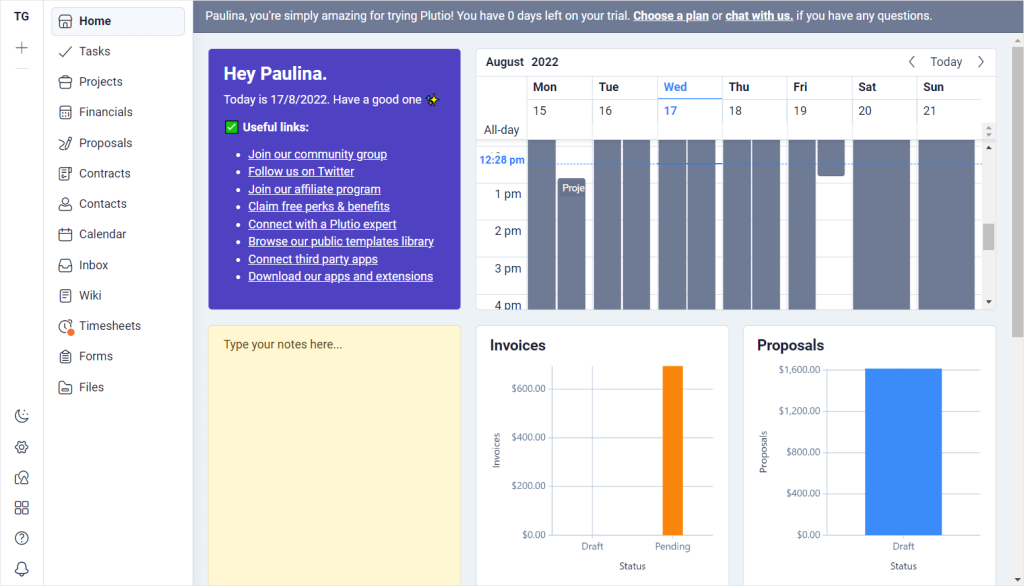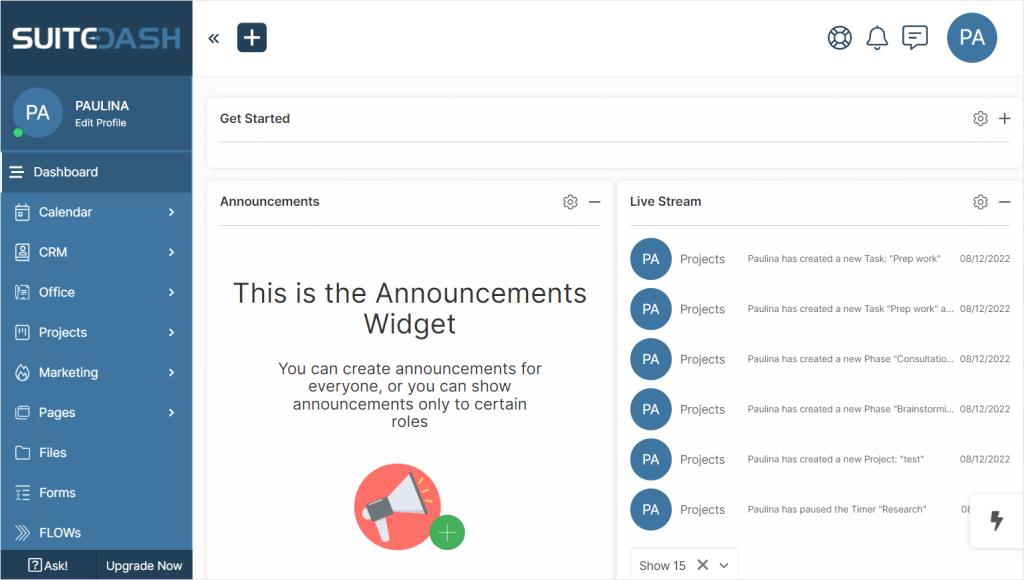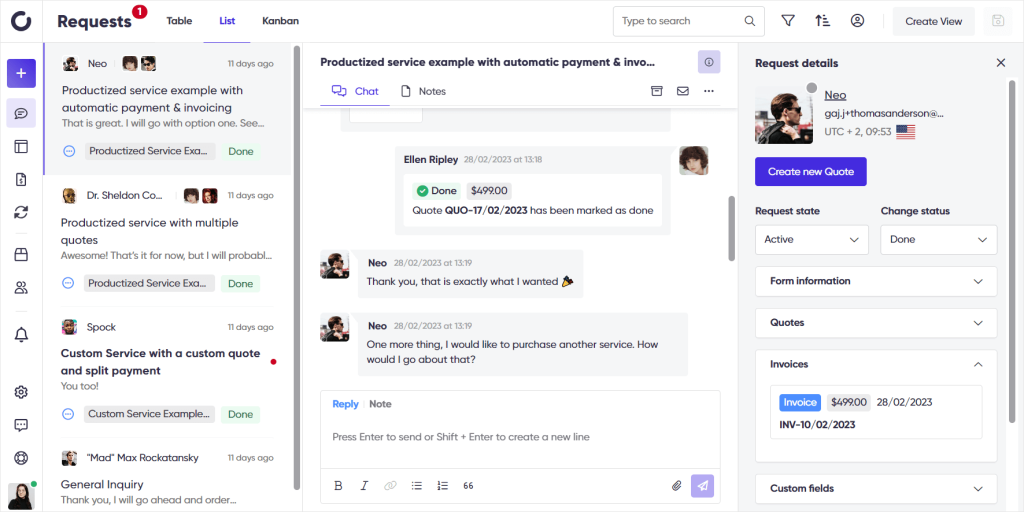Optimizing your business on all fronts is what can help you reach the full potential of your company. Ensuring there are no leaks, bottlenecks, and any issues that hold you back from maximizing your results can make a huge difference in ROI. And the best way to do that is to create processes that automate your business, resulting in faster and better results overall.
While it might seem overwhelming at first, it quickly becomes easy with the help of such software as the ones introduced in this article, Plutio vs SuiteDash. Both of them offer solutions to different problems that many businesses face so that everyone can find something suitable for themselves.
Introduction: Plutio
This business management software was created in 2015 by a web design freelancer, Leo Bassam, who, like many others in his profession, loved their craft but hated the necessary evil in the form of administrative tasks. Let’s face it: accounting isn’t the most excitable of hobbies.
Plutio was designed to lessen the amount of the most bothersome, boring, and repetitive tasks, resulting in high productivity and saved time that can be spent elsewhere. Also, at that time, most available software was team–oriented, and so there was a noticeable lack of tools for freelancers. And Plutio was supposed to fill that niche.
Often enough, Plutio is compared to Trello. And no wonder — it has robust Tasks and Projects features accompanied by Invoices, Proposals, and Contracts, which are lacking in typical project management software. Business owners who have had enough of using several apps will be relieved to hear that there is an all–in–one software that can replace them all.

Introduction: SuiteDash
SuiteDash is a true powerhouse that offers many different possibilities to satisfy all the business needs and requirements anyone might ever have. Because of that, some might call it universal, others — unnecessarily overpacked with advanced features, overwhelming, and rather slow.
SuiteDash was founded back in 2012 by Mike Lambert. Like all the founding stories, the impulse behind building the software started from a real need experienced by Mike. He wanted to gain back time through automation and enable his business to run on its own, without his constant supervision and micromanagement.
This rich business management platform promotes itself as an ultimate substitute for all the most popular apps at once, such as Slack, FreshBooks, Zapier, Salesforce, Asana, Dropbox, Mailchimp, and many others.

Plutio vs SuiteDash Comparison
Now, let’s see what each business management software has to offer and which does it better.
Time–Tracking
TLDR: Plutio offers more data, but SuiteDash has an omnipresent time–tracking widget.
If you’re working on an hourly basis, you know how bothersome it is to track work hours. It’s easy to forget to turn the tracker off or to switch to another task, especially if you have multiple billing rates set in place. Then you have to sum up all the hours and bill them to the client, fervently hoping there weren’t any big mistakes that would make you lose money. And it can get even more complicated once you have to track employee hours.
That’s why a convenient time–tracking tool that automatically converts your hours into an invoice can be such a blessing. Let’s see whether our picks can handle that task with grace.
In Plutio, you can track work in the Timesheets tab or in the Task tab for convenience. The Timesheets tab gives us data on overall tracked time, billable, non–billable, costs, paid, and unpaid. Thanks to this information, we can see whether we’re really making a profit and find ways of optimizing our business. Unfortunately, we have no graphs or any other form of data visualization that could make it easier for us. If we want to compare the specific periods of time, we can only do so by filtering (by date, project, category, and so on). And while this is useful on its own, it won’t be enough once your database grows.
On the upside, you can easily convert billable time into invoices and send them to your clients. Unfortunately, any changes made in the invoice concerning the hours won’t update the database automatically, so watch out for that.
If you’ve already started time–tracking a specific task, you can easily turn the timer off and on in the Tasks tab. But if you want to turn on time–tracking for a new task, it starts to get weird — apparently, you can either start the timer immediately after creating a task or you’ll have to dig into the task’s settings to turn it on by clicking on a tiny button that’s too easy to miss. So all in all, it’s neither intuitive nor convenient.
In SuiteDash, you need to actually dig around to find the time–tracking feature — it’s hidden under the Projects tab in the left navigation bar. Once found, it’s rather disappointing. You can manually add your hours, start the time–tracker, or turn the billable hours into invoices — and that’s it! No visual data, no advanced filters, just a very basic feature… but one which comes with an omnipresent, powerful widget.
Wherever you go in the SuiteDash, you’ll notice a sticky icon with a lighting symbol following you all over the software. Once clicked upon, you’ll be able to pick or create a task you’d like to have time–tracking turned on for. Yes — that’s the aforementioned widget! Because it’s within reach at all times, it couldn’t be more convenient to use. Also, the time counter will appear in your browser’s tab, never letting you forget that your time tracking feature is on, similar to a popular free time tracker, Calendly, or another software, Bonsai.
Task Management
TLDR: SuiteDash has better Task Management; all the tasks can be found in one place, while Plutio is allocating tasks in two different subpages for an unclear reason, confusing the users.
Task Management, along with Project Management, are two of the most important and basic features that often decide whether the software suits us or not. They need to be clear–cut, intuitive, and understandable for just about everyone. Is it like that in our chosen software?
In Plutio, Task Management is a bit of a mess. There are only two views — a list view and a timeline view — which are both filterable. In all views, you can see your own tasks, Project tasks, and Delegated tasks. Each task by default shows the start and due dates, who assigned the task to whom, and its ID. Additionally, you can interact with the task in several ways: you can leave a comment, create a subtask, add an attachment, start time–tracking and view the logged hours.
While this all sounds quite nice, there are two things lacking. First, no Kanban board, which has been a highly popular view for quite some time now, will certainly be a deterrent to teams used to working on it. And secondly, all tasks created in the Tasks tab are individual; meaning they cannot be assigned to a project. If you want to do that, you have to create tasks in the Projects tab instead.
On the upside, this could be useful for teams with different roles and permissions where you want to ensure that nobody meddles with the project itself. If you’re a freelancer though, this distinction might be mildly annoying.
In SuiteDash, there is no such distinction — Tasks can be found under Projects in the left sidebar, clearly indicating the hierarchy. There are two filterable views you can switch between list and card views, similarly to Plutio. All tasks have their ID, priority, title, project, client, and due date listed by default. While creating new tasks, you can also set estimated hours, tags, type (for example, bug or support), status (like assigned or completed), and task recurrence.
You can interact with the task in many ways: edit it, add comments, see the task’s history, upload files, and create subtasks. All in all, it’s similar enough to Plutio’s approach, but it’s all in one place.
Project Management
TLDR: Overall, project management in Plutio is simple yet enough, especially for self-employed professionals who like tidy documentation. Meanwhile, SuiteDash offers more automation and allows clients to send their requests directly in the business management software.
From Project Management features, we expect clarity, organization, and a good overview of what’s currently happening in your business. Let’s see how it looks in both software.
In Plutio, projects have three filterable views: list view, card view, and timeline view. Each project has assigned a title, client, status, members, budget, and a progress bar to track job completion. While creating a new project, you can additionally pick a template and add custom fields.
Right above all the projects listed, you can see a pipeline that shows each stage of the project, from the initial request stage to completion and delivery. Unfortunately, it’s not very interactive — if you want to see all pending projects, for example, you need to filter the projects instead.
But there are three features that show up in each project worthy of mention:
- Project timesheet — here, you can see all the hours logged in by you and your entire team. You can group and filter them as well as see how much you profit.
- Conversations — a simple chat box that allows you to exchange messages with your team. You can send attachments, tables, media, checklists, and many other useful things.
- Wiki — you can create a knowledge base for your team and for your clients alike, customize it to your heart’s content to reflect your brand, and manage permissions. This is a great substitute for all the tools that handle data management.
SuiteDash lists projects in a similar enough pattern, but with additional settings that allow project managers to set estimations concerning time and money.
When it comes to views, besides the standard list and card view, we’re also graced with the Kanban view we wanted to see so badly, which is only accessible through individual projects. And while we don’t get the typical visualization of pipeline management, we get phases instead with tasks assigned to them and a nice progress bar informing us of where we stand.
There are also two chat boxes: one for communicating with our team and another for our clients. Here, we can freely exchange attachments as well, but Plutio offers more options. Likewise, SuiteDash doesn’t have anything resembling Plutio’s wiki — instead, it has two unique features: work requests and project generators.
- Work requests are documents sent by clients who’d like to buy your services. They can be easily converted into Projects, Estimate, or Invoice.
- Project Generators automatically create pre-configured Projects once triggered, which is useful when dealing with the same recurring projects.
Payment Processing
TLDR: SuiteDash offers more payment processing options than Plutio, but Plutio is sufficient for owners of small businesses.
The best business management software doesn’t only keep us and our business in check, but it also ensures fast payments that are easy and convenient for both parties. After all, we wouldn’t want to lose money due to badly structured processes!
In Plutio, payments can be processed through Square, Stripe, PayPal, and a chosen bank. You can include both taxes and discounts (before tax). When creating invoices, you can choose from many currencies, and most importantly, you can choose between one–time, multiple, and recurring payments as a manual or auto–billing subscription.
You can invoice clients from several places, as well, by including the document in your Proposals and Forms.
Last but not least, there’s a nice little feature worth mentioning. If you like selling whole packages, offering many options to clients, or simply upselling, you can add Items to your proposal. They can be set as required or optional, as well as single or multiple–select. Unfortunately, this feature won’t be enough for those who’d like to wholly focus on productized services, but it’s a start.
SuiteDash supports more payment gateways than Plutio: you can pick from PayPal, Braintree, Authorize.net, Stripe, and Stripe ACH. There are also more payment types: your clients can pay with cash, credit cards, gift cards, checks, and barters. Similar to Plutio, you can set up one–time payments and subscriptions. In this case, though, subscriptions are not recurring invoices — instead, it’s automatically charging your client’s card each time. Because of that, billing becomes effortless and both parties save a huge amount of time.
What if your client subscribed to your services, but the amount of work differs between each payment, resulting in a different price? SuiteDash resolved that issue by introducing the Accumulating Generator, which enables adding items and billed hours alike to the base pricing as you go. Once the deadline strikes, it’ll be all turned into an invoice, and the tab will get cleared out to start anew.
Before invoicing, you can send an Estimate to your clients. Once they agree with it, it’ll be automatically turned into an invoice with the option to pay for it immediately.
When you create invoices, there are many options available for you:
- you can include items, discounts, and taxes,
- you can assign it to the subscription plan,
- you can send individual invoices to all the clients grouped into a Circle,
- you can allow for partial payment,
- you can disable online payments (if you want your client to pay by check, for example),
- you can use a third–party link to the payment,
- you can automatically send a thank-you message after completing the payment,
- you can vastly configure automation, from generating documents to sending all sorts of messages and moving the deal to another stage, among others.
Automation
TLDR: To automate your workflow in Plutio, you need integrations. In SuiteDash, automation is already built–in and offers many complex options.
If you care about streamlining your business to the max, workflow automation is something you should pay attention to. Is your chosen project management software capable of taking the weight off your shoulders? Let’s see.
Unfortunately, Plutio doesn’t offer much in this area. There might be some singular options here and there (like recurring tasks or creating projects when proposals are signed) but for the most part, everything has to be done manually. To the rescue come various integrations — with the help of Zapier, Pabbly, Make, and many others, you can create powerful workflows, which can easily manage projects for you.
In SuiteDash, automation options are so rich you can easily feel overwhelmed. You see them everywhere (for example, in Invoices, Tasks, Projects, or Proposals) and you’re able to create whole chains of them. While this gives us an amazing and wide range of possibilities, it’s a double-edged sword — such micromanagement doesn’t give us much leeway or flexibility in case of any pivots or changes. Also, a single mistake’s consequences might reach further, if it’s a part of a complex chain, leading to a domino-like effect. But all in all, if used wisely, SuiteDash’s automation capabilities can forever change the way you do your business.
Teamwork
TLDR: Both job management software were built with teamwork in mind, but SuiteDash is more suitable for huge teams with their own leaders.
In Plutio, there are four roles available by default: Owner, Co–owner, Client, and Contributor. They all come with different yet customizable permissions (what they can see, create, edit and move, for the most part). If this doesn’t meet your needs, you can create your own custom roles.
If you’re working with a team, you can view their timesheets, assign tasks to them, exchange comments, compare schedules, etc. All in all, simple things that allow you to keep track of what’s happening in your business.
SuiteDash though goes one (or even several) steps further. It offers more roles from the get–go: Super Admin, Admin, Project Manager, Office Manager, Teammate, Salesperson, Freelancers. The drawback — there are no custom roles. The aforementioned ones though are rich and varied enough to satisfy most needs.
When it comes to team management, the same basics as in Plutio are covered, and there are also some additions. For example, you can set different hourly rates for all the members of your team (and even set it to Private, so that nobody can see it). You can also impersonate them if you want to lead correspondence in their name, for example, or fix any issues.
But more importantly — while Plutio had a wiki, which could be potentially used as a source of information for your team members, SuiteDash has a Learning Management System (LMS). With it, you can create educational courses and training programs that are divided into Products, Courses, Modules, and Lessons. You can set their visibility and also make it available to your clients.
Customer Experience
TLDR: Both software can help you deliver excellent customer service, but SuiteDash offers more options.
There are some factors that make customer experience a truly blissful experience. First of all — rapid communication, secondly: easy processes, and lastly, being kept up to date at all times. Can our Job management software deliver all that?
Both Plutio and SuiteDash offer Client Portal software, a place where your clients can log in, view all the data pertaining to them, pay for their invoices, and chat with the team. As long as the team regularly updates all the information, the client can enjoy a deep insight into their project’s details and its current status.
In Plutio, clients can also create tasks, either for themselves or to be delegated to other people. This direct approach eliminates the number of messages that usually precede asking for a new thing to be done.
In SuiteDash, the Client Portal has a much broader use — it’s called a Portal Page and it can also be assigned to your team members or other collaborators. It’s fully customizable and even has Dynamic Data Placeholders. So even if you share one Portal Page with many people, the content for them will vary depending on their role and permissions.
Also, SuiteDash has a robust Client Relationship Management (CRM) feature. It divides clients into three categories:
- Leads — contacts with whom you don’t have a business relationship (yet), they don’t have access to the Portal,
- Prospects — you can share all sorts of promotional materials and other resources (Estimations, Proposals) with them; they can access your Portal,
- Clients — you can send them invoices and add them to projects.
Pricing
TLDR: Both pricing options seem fair enough, especially Plutio’s Studio plan ($39 per month) and SuiteDash’s Thrive ($99 per month).
Plutio has four plans available:
- Solo, for $19 per month,
- Studio, for $39 per month,
- Agency, for $99 per month,
- Enterprise, with custom pricing.
To learn more about Plutio pricing, read this article.
SuiteDash has three plans available:
- Start, for $19 per month,
- Thrive, for $49 per month,
- Pinnacle, for $99 per month.
To learn more about SuiteDash pricing, read this article.
What Should You Invest In?
Both software offer completely different possibilities and aim toward slightly different audiences.
Plutio, even though it offers plans for many contributors, is best suited for freelancers and small to medium teams. Even though there are certain features that support teamwork, they’re not enough on their own. Investing in multiple tools or integrations is necessary.
SuiteDash, on the other hand, was built to empower teams. It’s a powerful (but rather slow) tool that nonetheless requires marketing knowledge. If it’s your first time dealing with such an all–in–one solution, the learning curve will be steep. But it’s worth it for all the team–specific automation and project planning features that can simplify your work.
Looking for Different Project Management Capabilities?
If you still can’t decide what to choose and above all, you’d love software that combines the best of two worlds, we have another solution for you — Zendo.
Zendo offers simplicity and intuitive use with a cloud–based collaboration that helps teams reach their full potential. It doesn’t require any marketing knowledge or external consultants to set up. It’s been created with small to medium business owners in mind, who don’t necessarily have years of experience in dealing with business tools.

What features can you expect from Zendo:
- Support for productized, subscription-based, custom, and free services,
- Service Catalog, where you can show off your services in a professional form and where your clients can submit their orders,
- Direct client communication via real–time chat, which gives off more of a friendly and approachable impression,
- Quoting & Invoicing feature that allows you to create, send, and edit quotes & invoices directly in chat,
- Automation features to make your business run itself,
- Instant payment feature that allows your clients to pay you at once in the chat,
- Notes feature that allows you to exchange messages between your team with the client being none the wiser,
- Flexible workflows that give you enough structure to bring order to your business while giving you some wiggle room,
- White-label features to make the platform reflect your brand more,
- and so much more!
Zendo, being a new software on the market, had ample time to learn from the mistakes of multiple systems currently available, that is, overflowing with unnecessary features and trying to satisfy all possible needs. And you know what they say — if you try to please everyone, you please no one.
If you like simplicity and efficacy, as well as beautiful UX/UI design, give Zendo a try!

A free online training. Delivered daily to your inbox to grow your productized agency.
What Is Plutio?
Plutio is a business management tool whose biggest advantage lies in its project management capabilities. You can create boards, projects, tasks, subtasks, and spice them up with images and rich formatting options. With the help of timesheets, it’ll help you measure the time spent on projects and which jobs are truly profitable and which are a waste of your time.
What Is SuiteDash?
SuiteDash is a Client Portal Software that also offers a handy CRM, robust automation options, and a way to create onboarding and courses for both your clients and your team members. SuiteDash is suitable for bigger teams which are in need of some improvement when it comes to management, or those that have huge client database.
What Is Zendo?
Zendo is an all-in-one solution for business management that doubles as a proper client portal solution. It can help you with service creation and service selling, while a customizable Service Catalog will aid you in presenting your offer in a professional manner. Add to that upfront payments, a real-time chat, and subscriptions, and you get a powerful platform for managing your business!
Is Zendo Affordable?
Zendo has a Free Forever plan, which costs you nothing. For no penny at all, you gain access to most of the platform and you can invite another user to test it out with you. To make use of Zendo to the fullest, you get renewable Premium Tokens on top of that to be able to try out the Premium Features, such as subscriptions or white-label features.











